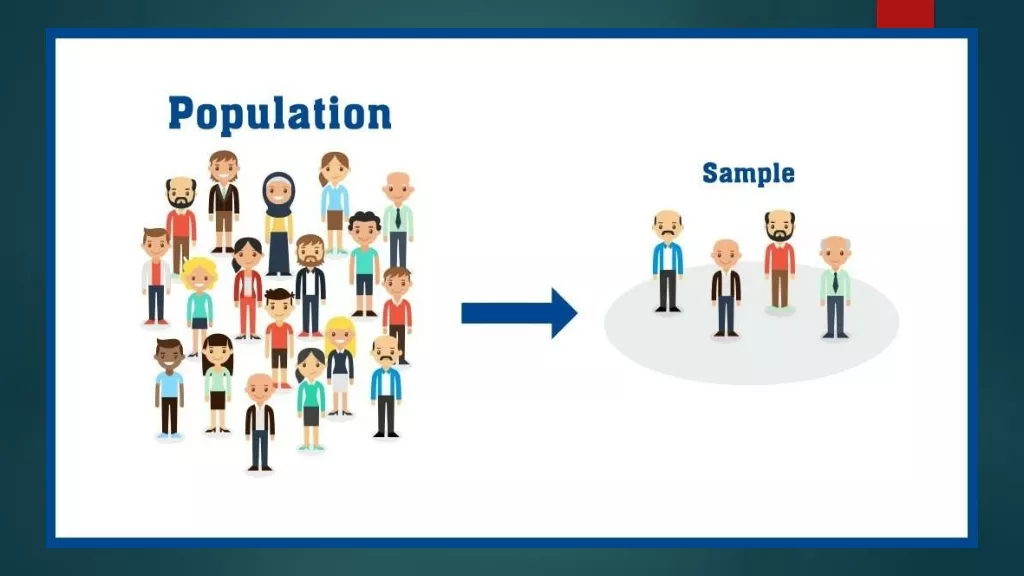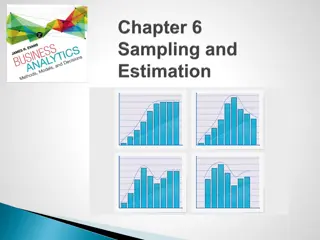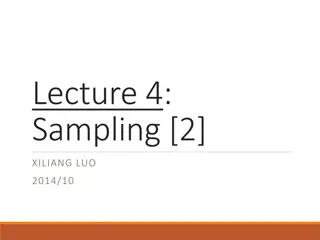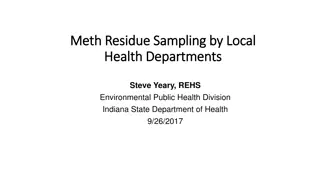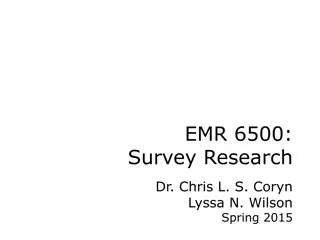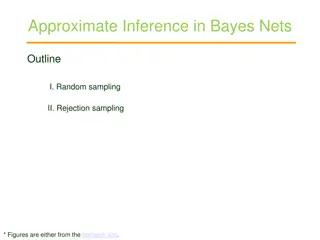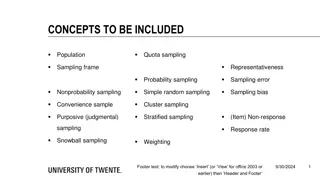
Sampling in Research: Methods and Importance
Learn about the significance of sampling in research, various sampling designs, and why good sampling is crucial for accurate results and generalizability. Explore the process, characteristics, and objectives of sampling in this comprehensive guide.
Download Presentation

Please find below an Image/Link to download the presentation.
The content on the website is provided AS IS for your information and personal use only. It may not be sold, licensed, or shared on other websites without obtaining consent from the author. If you encounter any issues during the download, it is possible that the publisher has removed the file from their server.
You are allowed to download the files provided on this website for personal or commercial use, subject to the condition that they are used lawfully. All files are the property of their respective owners.
The content on the website is provided AS IS for your information and personal use only. It may not be sold, licensed, or shared on other websites without obtaining consent from the author.
E N D
Presentation Transcript
Sampling Prof. Dr. Nadhim Ghazal Noaman
Session Objectives By the end of the session you will be able to: Explain what sampling means in research. Recognize important terms in sampling. List the different sampling designs available.
Sampling .. The perfect way in research work is to study the whole population. Is this always, feasible ,, practical ,, doable??? 3
What is Sampling Sampling {i.e. selecting (study units) from a whole population}. The population is too large for us to consider .. Instead we select a sample of individuals hoping that the sample is representative of the whole population. Extent to which research findings can be generalized to a larger pop.
Idea of Sampling Statistics The dependent variable can be generalised from n to N
Sampling . In any study, the Sampled population and the Target population should be similar to one another. Generilisability 6
Why we do good sampling? Practicality Reduce errors and bias Save time and money Feasibility Measurements may be better in sample than in entire population (precise results)
Sampling process is very critical step in methodology. WHY ?? It determines the power of the study and the degree of confidence for the results. Any defect in sampling will cause a defect in the accuracy of results and will question the internal and external validity of the whole study. 8
Basal Characteristics of good sample Should meet the entry criteria. A sample that can be studied at an acceptable cost in time and budget . Accessible . . Representative enough TO Allow generalizability Large enough to control (random error). 9
What is the group of people you want to serve (target pop)? What is the group of people from which we want to draw a sample (sample frame)? How many people do we need in our sample (sample size)? How will these people be selected (sampling design or technique)? 10
Sampling Plans A sampling plan is just a procedure outlines the steps of choosing our sample to represent the target pop. This is done through: 1- Define the Target population (TP) (e.g. All teenagers with DM allover the world in 2022). 2- Define the Accessible population (AP) (sample frame) is a subset of TP. (ex. Teenagers with DM living in Baghdad city in 2022). 3- Define the Intended study sample is the subset of (AP) seeks to include. (teenagers with DM living in karkh &/or Rasafa . 4- the Actual study sample . Real Participants. 5- Sample design .. The scheme for selecting the sampling units from the study population. 11
Sampling terms Target Population (TP) is the all people or subject to which you wishes to generalize the findings of your study, all the pregnant teenagers are your target pop, Sample frame is a subset of the TP. E.g the no. of pregnant teens that you have. (your pop.) from which you identify your sample. Sample unit on which the observations will be collected. For example, persons in a study of disease prevalence, or households, in a study of family size. 12
Specification of sample unit: Done by inclusion and exclusion criteria: Inclusion criteria: (Be specific) the key features of the target and accessible pop. That you will use to answer your research question. On basis of demographic and clinical characteristics and geographic temporal characters e.g: black male 45 - 50y of age with fever and maculopapular rash attending specific hospitals, between Jan/1st to Dec. June1st/2022) Exclusion criteria: (Be ungenerous) people with eligibility criteria, but may interfere with the inferences because of other additional criteria as smoking, alcoholics, or plan to leave the province, language barrier, other comorbidities, pregnancy
Sampling designs .. Probability sampling (Randomized Sampling) : Random selection .. each unit chosen on the basis of chance. All units should have an equal chance of being included in the sample. Its gold standard for generalizability. Why? Used whenever a scientific need for generalizability Non-Probability sampling (Non-Randomized Sampling) Use non-random criteria: - availability, - geographical proximity, - expert knowledge to recruit study participants. - Based on subjective judgment. All are less stringent. 14
Sampling designs .. I- Probability Sampling Methods 1) Simple random sampling 2) Systematic Sampling 3) Stratified Sampling 4) Cluster Sampling 5) Multi-stage sampling 15
1) Simple Random Sampling Its simplest most common and very precise. When we have a Defined pop. Select the required number of sampling units, using a lottery method as: A table of random numbers. Coin Computerized randomization lists Other 5.16
2) Systematic Sampling .. Individuals are chosen at regular intervals from the sampling frame (every nth, as 5th, 10th, etc.), but starting at a random point (n) could be any No. according to the size of the pop. and the size of the sample we need. 17
3) Stratified Random Sampling If it is important that the sample includes representative groups of study units with specific characteristics (for example, residents from urban and rural areas), Then the sampling frame must be divided into groups, or strata, according to these characteristics. then drawing simple random samples from each stratum. E.G. Sex, age, economic, occupation, geographical distribution, . We achieve the Weighted mean randomly .. We can acquire about the total population, make inferences within a stratum or make comparisons across strata 5.18
3) Stratified Random Sampling The advantage: is that the sample should be highly representative, can generalize ... The disadvantage: would be extremely time-consuming and difficult to do. 5.19
4) Cluster sampling . When the pop is widely dispersed, impractical to list (country, provinces..). The selection of groups of study units (clusters) instead of the selection of study units individually is called cluster sampling. Clusters are geographic units (e.g. districts, villages). These clusters can be randomly selected. As community based study. Take pop. Density in consideration. 20
The groups created in cluster sampling are heterogeneous stratified sampling are homogeneous share characteristics. In cluster sampling groups and include all units of each group in your sample. However, in stratified sampling some units of all groups and include them in your sample. Both methods can ensure that your sample is representative of the target population. heterogeneous, In contrast, groups created in homogeneous, as units cluster sampling you randomly select entire in stratified sampling, you select 21
5) Multistage sampling This method is appropriate when the population is large and widely geographically scattered. The number of stages of sampling is the number of times a sampling procedure is carried out. Using smaller and smaller groups at each stage. Advantages: less costly, we only need to draw up a list of individuals in each stage actually selected, and we can do that when we arrive there. Disadvantage: less precise than SRS. 22
Sampling designs .. Non-Probability sampling (Non-Randomized Sampling): 1) Convenient sampling 2) Consecutive sampling 3) Judgmental sampling (purposive). 4) Quota sampling. 23
Convenient sampling Very common, non-random sampling. This involves selecting the nearest people that happen to be available at the time of data collection, from an undefined sampling frame. Convenient and easy for researcher. Disadvantages No statistical justification for sample.. unsatisfactory way to conduct research. Not representative
Convenient sampling On the other hand, if sampling involves stopping people at random. What type of sampling is? Also, convenient sample as not everyone has an equal chance of being selected depending on the place, time, or day you are collecting your data.
Consecutive sample Consecutive means taking the entire accessible people over a long enough period of time. A case series of all consecutive patients with a condition of interest, within a hospital or clinic or PHC Advantages: Minimize volunteerism and other selection biases. Removes investigator from deciding who enters a study. Requires case definitions of condition of interest Straightforward way to enroll subjects Include seasonal variations or other temporal changes that are important to the research question why? Disadvantage Non-random
Consecutive sample Outcome of 500 consecutive patients presenting to the emergency room with acute pancreatitis. Explicit efforts must be made to identify and recruit ALL persons with the condition of interest
Quota sampling: Is a method that insures that different categories of sample unit with specific characteristics are represented in the sample. In this method the investigator interviews as many people in each category of study unit as he can find until he has filled his quota. 28
Both involve dividing the population into subgroups and selecting units from each subgroup. The purpose in both; - To select a representative sample. - To allow comparisons between subgroups. The main difference is that in stratified sampling, you draw a random sample from each subgroup (probability sampling). In quota sampling you select a predetermined number or proportion of units, in a non-random manner (non-probability sampling). 29
Purposeful sampling strategy for qualitative studies. The above sampling methods do not claim to be representative of the entire population. Its convenient to research not researcher. 30
Snowball sampling A recruitment technique in which research participants are asked to assist researchers in identifying other potential subjects. The chain referral process is best used in the following cases: If there is no sampling frame available ( a rare disease) If the population of interest is hard to access or locate (e.g., homelessness) If the research focuses on a sensitive topic (e.g., extramarital affairs) 31
When to use non When to use non- -probability sampling sampling When conducting a qualitative research, to study a particular issue in depth analysis. When you do not intend to generate results, as pilot study. When we have a limited time or budget. When we cannot afford a random sampling, we can choose from the non-random. If our aim is to measure disease distribution, or to test hypotheses. we need to generalize the finding. Then, probability sampling methods have to be used. probability 32
Which sampling design is best? The best sampling method is that: Could best answer our research question. Allowing generalizability of results. Choose the method that gives the greatest degree of accuracy and precision for a given cost. How can achieve that ?? Which is more commonly used method?? Sample size: the larger the sample size is, the more accurate. Why ??

